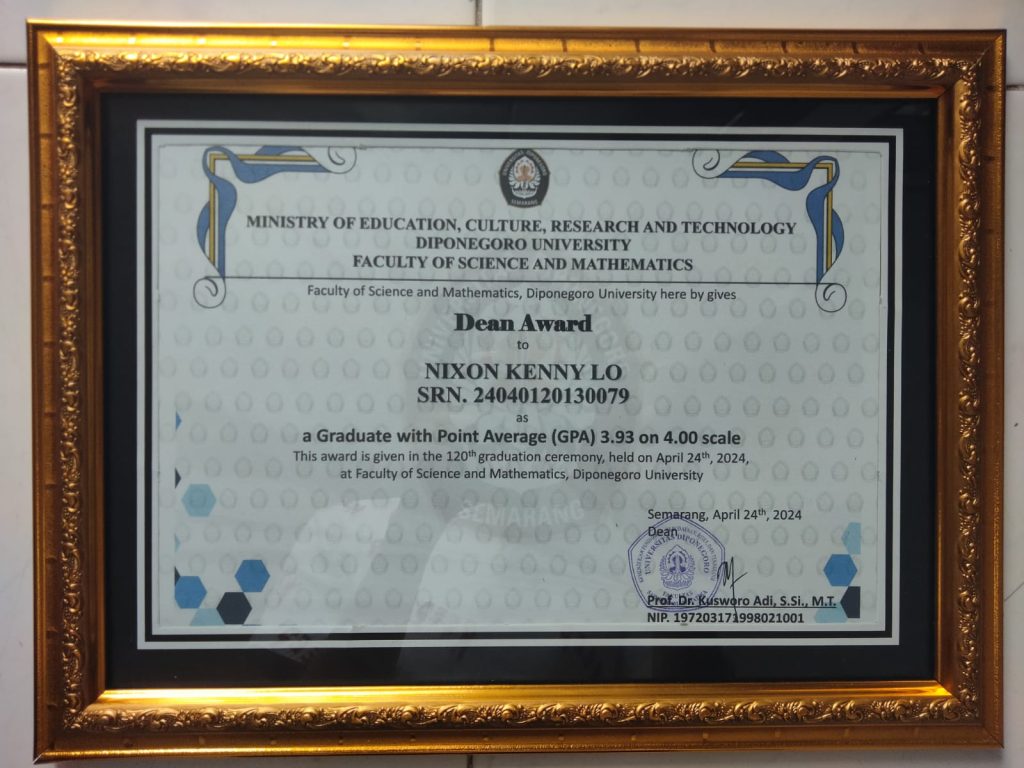Congratulations to the bachelor’s and master’s graduates of UNDIP Physics for the April 2024 period on their remarkable achievements. We hope that you will soon secure your dream jobs, start your own businesses, or continue your studies. At this graduation ceremony, a Physics student from UNDIP, Nixon Kenny Lo, received the Dean’s Award. Previous recipients of the Dean’s Award from the UNDIP Physics department include Achmad Fajar (Ph.D. France), Susilo Hadi (Ph.D. France), and Sera (Ph.D. UNDIP).
Nixon was honored for his publications: “Producing Fe and Cu Ions and Oxides in Water with Electrolysis as Artificial Liquid Waste” (Co-author), IOP Conference Series: Earth and Environmental Science, 2022; and “Effects of Copper and Bismuth Dopants on PVA/NBT Film as an X-ray Dosimeter” (First-author), Materials Chemistry and Physics, 2024. Nixon also received funding for the Student Creativity Program – Exact Research (PKM-RE) 2023.
Nixon’s research focuses on the development of effective and accurate dosimetry methods driven by the realization of the dangers of ionizing radiation, especially to radiation workers. Low-dose X-rays with an average entrance surface dose (ESD) in the milligray range are utilized in diagnostic radiology. However, the limitation of effective and accurate dosimeters for detecting low-dose X-rays remains a challenge in practice. This research aims to develop polyvinyl alcohol (PVA) based films doped with nitroblue tetrazolium (NBT), reported to have good radiosensitivity properties for low-dose X-ray radiation. Additionally, the study investigates how the addition of copper(II) and bismuth(III) ions influences the film’s ability to detect X-ray radiation in terms of sensitivity and linearity of response.
The films synthesized using the solvent casting method were irradiated with X-rays in the ESD range of 0 to 3.576 mGy using a mobile radiography machine. Optical characterization of the films was performed through optical density measurements, UV-Vis spectrophotometry, and infrared spectrophotometry (FTIR). The results showed that adding copper(II) ions to the PVA/NBT film increased its sensitivity and response linearity, with a sensitivity value of 0.0017 mGy−1 and an R² value of 0.98 for the PVA/NBT-Cu²⁺ film irradiated at 81 kVp. The PVA/NBT-Cu²⁺ film also demonstrated an optical response with decreased UV-Vis transmittance and increased infrared absorption at specific absorption bands with increasing radiation dose. In contrast, the addition of bismuth(III) ions did not contribute to improving the PVA/NBT film’s response to X-rays. Nixon’s research was supervised by Prof. Dr. Heri Sutanto, S.Si., M.Si., F.Med, and Zaenal Arifin, M.Si., F.Med.


